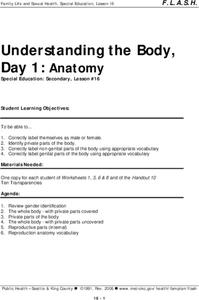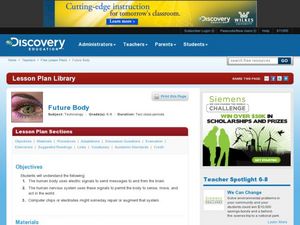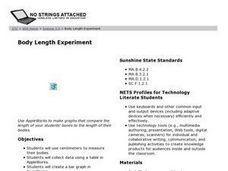Curated OER
Understanding the Body, Day 1: Anatomy
Students review gender identification and label themselves female or male. They identify the parts of the human body and practice using appropriate vocabulary. They complete a worksheet to complete the lesson.
Curated OER
Do You Have the Guts?
Seventh graders Name and locate the major internal organs of the human body and the frog. Students virtually dissect a frog and compare organs to the human organs. Students draw illustrations of their learnings.
Curated OER
BELT-ABOUTS LESSON 2
High schoolers explain why safety belts don't fit all children. They decribe the correct way to wear a safety belt. Students explain why incorrect belt fit can be dangerous. They are shown a diagram of the human body. High schoolers...
Curated OER
IDENTIFYING PARTS OF THE BODY
Pupils identify and describe the various parts of the body therefore, practicing English vocabulary, pronunciation, and spelling. They discuss the various body parts, some of the inner organs and also, their functions. Finally, students...
Curated OER
Internal Anatomy: A Fun Look At The Digestive System
Young scholars look at the functions of the body. In this biology lesson plan, students explore the functioning of some body part and construct a "living doll" composed of the body parts discussed.
Curated OER
Whose Parts Do I Have? (Wings and Things)
Students identify an animal and a body part and then matches a body part to a specific animal. This will assess their ability to sort organisms and objects into groups according to their parts and describe how the groups are formed and...
Curated OER
Beautiful Bovine
Learners compare and contrast a human body to a cow. Using a diagram, they label and identify the functions of the cow's numerous parts. In groups, they create a Venn Diagram to compare the various types of cows with one another. They...
Curated OER
Better Body Books, Inc.
Pupils work in groups of 2-3 people to prepare a book about the human body that is suitable for a 3rd, 4th, or 5th grade student.
Curated OER
Where Does the Blood Go?
Students investigate where the blood in our hearts travels by observing a diagram in class. In this cardiovascular lesson, students examine their own heart by checking their pulse in class. Students investigate a human body...
Curated OER
Three Dimensional Art of Vertebrates and Invertebrates
Students, during this twelve week series of lessons, learn basic anatomy through life sketches of human skeletons and shells. They learn fundamentals of line and convey life through sketches learning science through art.
Curated OER
Organ System Interactions
Eighth graders who have studied all of the organ systems now discover how they all are related and work together in the human body. They discuss a variety of situations in which more than one system plays a part. They identify the...
Missouri Department of Elementary
How Much Does Smoking Really Cost?
Following a brief survey about tobacco, scholars examine a fact sheet to answer questions about the substance. A practice page challenges the class to determine the cost of the habit using money math. Pupils discuss their findings...
Curated OER
Reproduction, Day 1: Reproductive System
Engage Secondary Special Education high schoolers in a developmentally appropriate lesson on human reproduction. They review genital anatomy and 5 key components that comprise the reproductive cycle. Perfect for a mild to moderately...
Baylor College
Heart and Circulation: Pre- and Post-Assessments
Middle schoolers demonstrate what they know about the structure and function of the heart and blood vessels. A set of 15 multiple-choice questions also addresses how the heart handles microgravity and how animals without...
Nemours KidsHealth
Head Lice: Grades K-2
Head lice—how not to get or give it. Scholars read or listen to kid-friendly articles that offer information about head lice. They complete a worksheet that identifies items they should and should not share with their peers.
Towson University
Looking Into Lactase: Guided Inquiry
Milk does a body good ... unless, of course, someone is lactose intolerant. Pupils play the role of pharmaceutical scientists in a guided inquiry lab about lactase. Lab groups collaborate to learn more about lactose intolerance, how...
Curated OER
Why Doesn't My New Shirt Fit?
Learners test Leonardo da Vinci's view of the human body by measuring various body parts using a tape measure. They create a data table and a scatter plot and then analyze and interpret the results using a graphing calculator.
Curated OER
Fun Bones
Use the hokey pokey music to teach the names of some of the major bones in the human body. Circle up, put on the music, and put your right radius in. Use this in an anatomy class to spice things up a bit!
Curated OER
Future Body
Young scholars explain the benefits of cyborg augmentation. In this technology lesson plan, students research how the nervous system works. They create posters and present them to class.
Curated OER
P.L.E.P: Parts of Blood
Middle schoolers examine the different parts of blood. In this human blood lesson plan students work in groups and identify parts of blood and construct a model of human blood.
Curated OER
Organ Systems: Excretory, Digestive, Immune, and Nervous
Eighth graders identify and describe the components of various body systems. They create vocabulary flash cards identifying the excretory, digestive, immune, and nervous systems and describing their functions. Students complete a...
Curated OER
Stop the Bleeding
Learners explore various parts of the heart and blood vessels . They begin with an overview of the components of the cardiovascular system. They see a cross section of an artery and watch how a blood clot develops.
Curated OER
Body Length Experiment
Students measure the lengths of their bodies and various body parts to determine the relationship (or lack of one) between body part length and the length of the entire body. A spreadsheet program is suggested for data collection.
Curated OER
How to Make a Model of the Human Respiratory System
Students label parts of the human respiratory system on a diagram. They explain the function of diaphragm.























